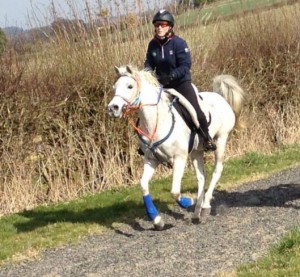 Written by Olivia Colton MSc Tying-up, Monday morning disease, exertional rhabdomyolysis, setfast and azorturia are alternative names for the same condition. We still do not know all the answers about this muscular disorder, though modern research is helping us see how and why horses tie-up a little clearer. What is tying-up? Tying up can affect horses differently depending on the severity of the attack. If being exercised the horse’s gait can become stiff and stunted. This will worsen with more exercise. If the horse is still they may be reluctant to bear weight. It is usually the hind quarters that are most affected, and these will look tense, and be sore to touch. The condition is painful, and the horse may sweat and show other signs of pain such as increased respiratory and heart rate. In severe cases the horse’s urine may turn red- this is called myoglobinuria, and is due to protein (myoglobin) leaking into the blood due to muscle damage. How can I tell if my horse is tying up? If you suspect your horse has tied up, call your vet, who can confirm this through blood tests. If your horse has suffered from muscle damage there will be increased activity of creatine kinase (CK) and aspartate animotransferase (AST), proteins which are contained in healthy muscle cells, and are released into the blood stream when damage to muscle cells occurs. Why do horse’s tie-up? Horses that tie-up can be defined as suffering from either: PSSM (polysaccharide storage myopathy) or Rhabdomyolysis, which can be split into:
Written by Olivia Colton MSc Tying-up, Monday morning disease, exertional rhabdomyolysis, setfast and azorturia are alternative names for the same condition. We still do not know all the answers about this muscular disorder, though modern research is helping us see how and why horses tie-up a little clearer. What is tying-up? Tying up can affect horses differently depending on the severity of the attack. If being exercised the horse’s gait can become stiff and stunted. This will worsen with more exercise. If the horse is still they may be reluctant to bear weight. It is usually the hind quarters that are most affected, and these will look tense, and be sore to touch. The condition is painful, and the horse may sweat and show other signs of pain such as increased respiratory and heart rate. In severe cases the horse’s urine may turn red- this is called myoglobinuria, and is due to protein (myoglobin) leaking into the blood due to muscle damage. How can I tell if my horse is tying up? If you suspect your horse has tied up, call your vet, who can confirm this through blood tests. If your horse has suffered from muscle damage there will be increased activity of creatine kinase (CK) and aspartate animotransferase (AST), proteins which are contained in healthy muscle cells, and are released into the blood stream when damage to muscle cells occurs. Why do horse’s tie-up? Horses that tie-up can be defined as suffering from either: PSSM (polysaccharide storage myopathy) or Rhabdomyolysis, which can be split into:
- Recurrent exertional rhabdomyolysis– where the horse tied-up on various occasions
- Sporadic exertional rhabdomyolysis– horses that tie up once or very rarely
 Sporadic exertional rhabdomyolysis often occurs when the horse is expected to perform a bout of exercise which is above their fitness levels. It often happens when a horse has a compromised respiratory system. It can also show a deficiency in vitamin E and Selenium. Not having enough vitamin E and Selenium, which work synergistically to form the most important antioxidant for muscle cells, contracting oxidative damage. Imbalanced levels of electrolytes may also contribute. The problem will usually occur during or after exercise. Certain breeds are predisposed to the Recurrent form of the disorder, which is thought to be linked to a genetic mutation, and noticeably highly strung breeds such as TBs, TB crosses and Arabs are affected, suggesting that stress may play a role. Mares are also more likely to suffer. It is thought that electrolyte imbalances can be a major factor, which makes sense as these salts play a major role in muscle function, and are lost during exercise via sweat. As mentioned above, lack of antioxidant Vitamin E and Selenium can also contribute. Risk factors for Rhabdomyolysis:
Sporadic exertional rhabdomyolysis often occurs when the horse is expected to perform a bout of exercise which is above their fitness levels. It often happens when a horse has a compromised respiratory system. It can also show a deficiency in vitamin E and Selenium. Not having enough vitamin E and Selenium, which work synergistically to form the most important antioxidant for muscle cells, contracting oxidative damage. Imbalanced levels of electrolytes may also contribute. The problem will usually occur during or after exercise. Certain breeds are predisposed to the Recurrent form of the disorder, which is thought to be linked to a genetic mutation, and noticeably highly strung breeds such as TBs, TB crosses and Arabs are affected, suggesting that stress may play a role. Mares are also more likely to suffer. It is thought that electrolyte imbalances can be a major factor, which makes sense as these salts play a major role in muscle function, and are lost during exercise via sweat. As mentioned above, lack of antioxidant Vitamin E and Selenium can also contribute. Risk factors for Rhabdomyolysis:
- Predisposed breed
- Hard, fast exercise
- Exercising above training/fitness level
- Lack of warming up/cooling down
- High starch diets
- Box rest
How can I help my horse with Rhabdomyolysis? By careful management of exercise and diet, tying-up can generally be well controlled. Exercise and management:
- Make sure your horse is fit enough to undertake the work asked of them
- Ensure you warm up and cool down for long enough
- Keep your horse warm by rugging when necessary after exercising, especially if they have been sweating
- Maximise turnout
Diet:
- Do not feed hard food or cereal to horses that suffer from tying-up
- Feed high fibre diets
- If your horse needs bucketed feed try Alfalfa
- If your horse requires extra energy add in unmolassed sugar beet and oil
- Feed a supplement which provides antioxidants Vitamin E and Selenium
- Feeding electrolytes is also advised
PSSM is a separate condition which leads to an abnormal storage of glycogen within the horse's muscles, leading to symptoms mentioned above. Horses with PSSM seem to be more sensitive to insulin, which stimulates uptake of glucose to the muscles, where it is stored as glycogen. This is thought to be a genetic disorder, as it can be due to a mutated gene, though horses can suffer from PSSM that do not have this gene mutation. This typically affects warmblood, draught horses and quarter horses, and with this problem, either gender is equally likely to be affected, and the attack will usually occur at the beginning of exercise. Risk factors for PSSM:
- Genetic disorder
- Predisposed breed
- Lack of daily exercise
- Lack of turnout
- High cereal diets
How can I help my horse with PSSM? By careful management of exercise and diet, tying-up can generally be well controlled. Exercise and Management
- Daily exercise will help muscles to use the stored glycogen
- Make sure the horse has long and steady warm-up and cool down periods
- Live out or have long periods of daily turnout, but if grass is lush, use a non-grassed turnout area or starvation paddock to reduce intake!
Diet:
- Remove cereals from the diet as these lead to insulin spikes, and increased blood glucose
- Feed forage only diet if possible, and get hay tested to ensure it is not high in carbohydrates
- Balance the diet using a vitamin and mineral supplement
- To help with muscular health, consider providing a supplement that provides vitamin E and Selenium
- If extra energy is needed, provide this by using unmolassed sugar beet, oils and fats, or a condition supplement
- Feed electrolytes as necessary
If you would like any further information please call our FREE phone helpline on 0800 585525 or contact Olivia directly by email [email protected]











